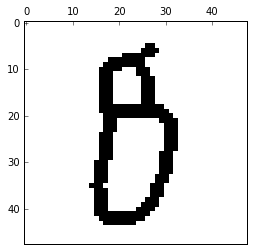%matplotlib inline
import pylab as plt
import pandas as pd
import numpy as np
概要
前回、FaxOCRという手書き数字のデータの認識をやった。
認識自体はぼちぼちできたが、MNISTデータで学習させたCNNで認識を行うといまいちだったのが気になった。
バグやミスの可能性を潰してもう一度やってみたけど、同様にうまくいかなかった。
データを見ていると文字のサイズが異なっていることに気づいた。
サイズを統一してやってみると、MNISTデータで学習させたCNNである程度正しく予測することができた。
はじめに
前回、FaxOCRという手書き数字のデータの認識をやった。
学習データを回転させるなどしてデータを増やして、CNNを使って学習させると、96%ぐらいの精度で予測することができた。
一方で、MNISTのデータを使って学習させたCNNでは70%弱でしか当てることができなかった。
自分のプログラムや計算にミスがある可能性も考えながら、色々やる。
今回はMNISTデータとの違いを見ることが目的なので、FaxOCRのデータは全て前処理されていない元画像データ(numbers-sample, mustread)を使った。
FaxOCRについてはこちら。
ミスの可能性をなくす
全部画像データに変換する
前回はMNISTのデータをバイナリで読み込んでCNNやt-SNEに突っ込んでいた。やらかしているならここだなと思って、とりあえず全部pngにした。
import pylab as plt
from sklearn.datasets import fetch_mldata
import numpy as np
def save(image, name):
fig = plt.figure()
ax = fig.add_subplot(1, 1, 1)
imgplot = ax.imshow(image, cmap=plt.cm.Greys)
imgplot.set_interpolation('nearest')
ax.xaxis.set_ticks_position('top')
ax.yaxis.set_ticks_position('left')
plt.imsave(name)
mnist = fetch_mldata('MNIST original', data_home=".")
y = mnist.target
X = - mnist.data.reshape(len(y), 28, 28) + 255
counter = np.zeros(10)
from itertools import izip
for image, label in izip(X, y):
label = int(label)
plt.imsave("%d_%d.png" % (label, counter[label]), image, cmap=plt.cm.gray)
counter[label] += 1
プレビューが死ぬほど重いけど、特に問題なさそう。
FaxOCR
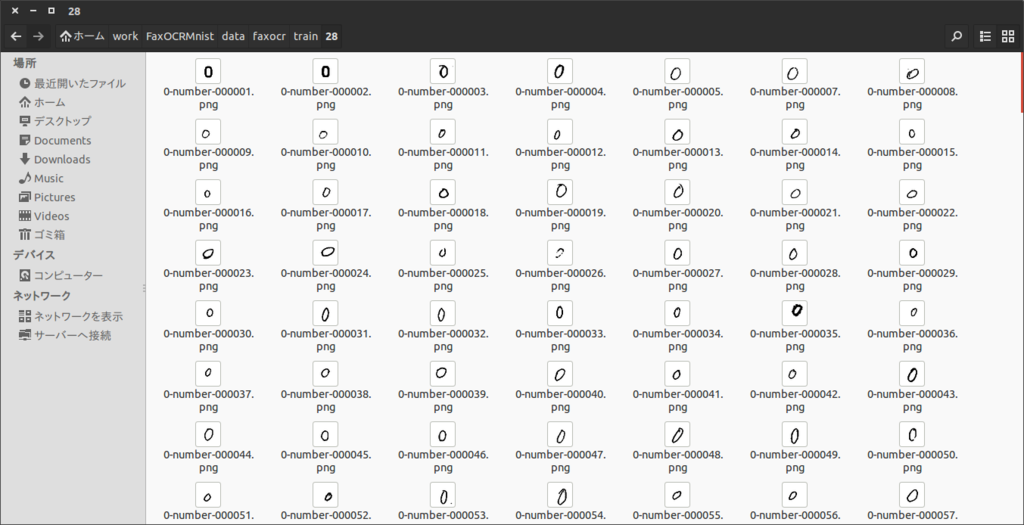
MNIST
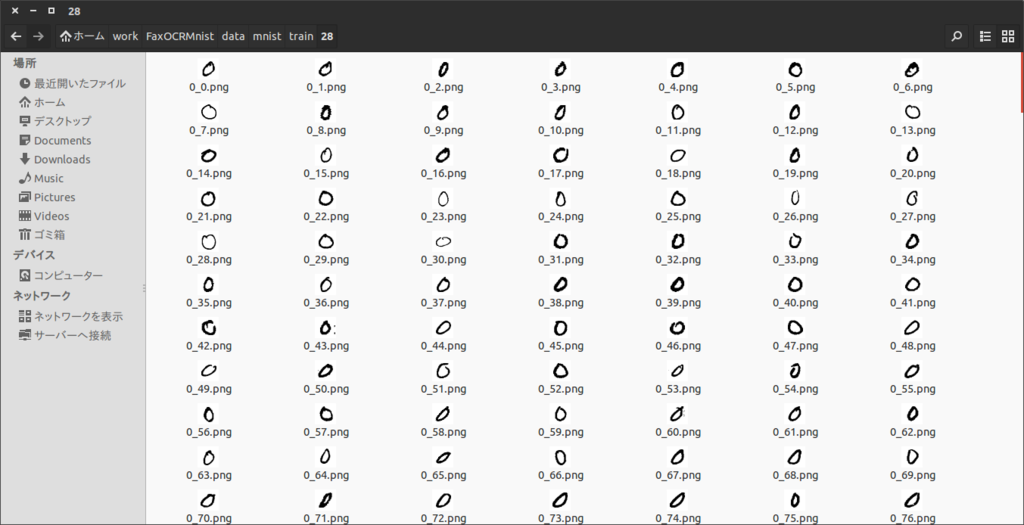
FaxOCRのデータは以下のようにImageMagicを使って、28x28に変えた。
for i in *
do
convert -resize 28x28! $i ../28/$i
done
CNNのコードを書き直す
ネットにあったコードを行き当りばったりな感じで編集してコードを書いていた。
コメントアウトで条件変えたり、ミスしてそうなところがあったので、そこそこちゃんと書き直す。(書きなおしたあと色々あってまた行き当りばったり的なコードになっているけど気にしない)
learn.py
import numpy as np
import glob
import cv2 as cv
from itertools import izip
import random
from cnn import cnn
def read_imgs(dirname, labelpos=1):
imgs = []
labels = []
for img_file in glob.glob(dirname + "/*.png"):
imgs.append((255 - cv.imread(img_file, flags=0)) / 255.0)
labels.append(int(img_file[len(dirname) + labelpos]))
return np.array(imgs), np.array(labels)
def learn(train="faxocr", imsize="28"):
X_test, y_test = read_imgs("./data/faxocr/test/%s" % imsize)
X_train, y_train = read_imgs("./data/%s/train/%s" % (train, imsize))
size = tuple(np.array([X_train[0].shape[1], X_train[0].shape[0]]))
if train == "faxocr":
new_imgs = []
new_labels = []
for img, label in izip(X_train, y_train):
for i in range(20):
rad = (random.random() - 0.5) * 0.5
pos1 = (random.random() - 0.5) * 5
pos2 = (random.random() - 0.5) * 5
mat = np.float32([[np.cos(rad), -1 * np.sin(rad), pos1],
[np.sin(rad), np.cos(rad), pos2]])
dst = cv.warpAffine(img, mat, size, flags=cv.INTER_LINEAR)
new_imgs.append(dst)
new_labels.append(label)
X_train = np.r_[X_train, new_imgs]
y_train = np.r_[y_train, new_labels]
cnn(X_train, y_train,
X_test, y_test,
"./results/" + train + "_%s_" % imsize, size=28)
if __name__ == '__main__':
learn(train="mnist", imsize="trim_28")
cnn.py
import numpy as np
import chainer
from chainer import cuda
import chainer.functions as F
from chainer import optimizers
import time
def cnn(train_data, train_label,
test_data, test_label,
resultname_header,
n_epoch=50, batchsize=100,
size=28):
cuda.check_cuda_available()
xp = cuda.cupy
N = train_label.size
N_test = test_label.size
train_data = train_data.reshape(len(train_label), -1)
train_data = train_data.astype(xp.float32)
train_label = train_label.astype(xp.int32)
test_data = test_data.reshape(len(test_label), -1)
test_data = test_data.astype(xp.float32)
test_label = test_label.astype(xp.int32)
train_data = train_data.reshape((len(train_data), 1, size, size))
test_data = test_data.reshape((len(test_data), 1, size, size))
print test_data.shape
print train_data.shape
print test_data.mean()
print train_data.mean()
if size == 28:
model = chainer.FunctionSet(conv1=F.Convolution2D(1, 20, 5),
conv2=F.Convolution2D(20, 50, 5),
l1=F.Linear(800, 500),
l2=F.Linear(500, 10))
else:
model = chainer.FunctionSet(conv1=F.Convolution2D(1, 20, 3),
conv2=F.Convolution2D(20, 50, 3),
l1=F.Linear(6050, 800),
l2=F.Linear(800, 10))
cuda.get_device(0).use()
model.to_gpu()
def forward(x_data, y_data, train=True):
x, t = chainer.Variable(x_data), chainer.Variable(y_data)
h = F.max_pooling_2d(F.relu(model.conv1(x)), 2)
h = F.max_pooling_2d(F.relu(model.conv2(h)), 2)
h = F.dropout(F.relu(model.l1(h)), train=train)
y = model.l2(h)
if train:
return F.softmax_cross_entropy(y, t)
else:
return F.accuracy(y, t)
optimizer = optimizers.Adam()
optimizer.setup(model)
fp1 = open(resultname_header + "accuracy_row.txt", "w")
fp2 = open(resultname_header + "loss_row.txt", "w")
fp1.write("epoch\ttest_accuracy\n")
fp2.write("epoch\ttrain_loss\n")
start_time = time.clock()
for epoch in range(1, n_epoch + 1):
print "epoch: %d" % epoch
perm = np.random.permutation(N)
sum_loss = 0
for i in range(0, N, batchsize):
x_batch = xp.asarray(train_data[perm[i:i + batchsize]])
y_batch = xp.asarray(train_label[perm[i:i + batchsize]])
optimizer.zero_grads()
loss = forward(x_batch, y_batch)
loss.backward()
optimizer.update()
sum_loss += float(loss.data) * len(y_batch)
print "train mean loss: %f" % (sum_loss / N)
fp2.write("%d\t%f\n" % (epoch, sum_loss / N))
fp2.flush()
sum_accuracy = 0
for i in range(0, N_test, batchsize):
x_batch = xp.asarray(test_data[i:i + batchsize])
y_batch = xp.asarray(test_label[i:i + batchsize])
acc = forward(x_batch, y_batch, train=False)
sum_accuracy += float(acc.data) * len(y_batch)
print "test accuracy: %f" % (sum_accuracy / N_test)
fp1.write("%d\t%f\n" % (epoch, sum_accuracy / N_test))
fp1.flush()
end_time = time.clock()
print end_time - start_time
fp1.close()
fp2.close()
import cPickle
model.to_cpu()
cPickle.dump(model, open(resultname_header + "model_cnn_row.pkl", "wb"), -1)
学習結果
ミスしそうなところはだいたい直したので、もう一度CNNを使って学習させてみた。以下は結果。
FaxOCR -> FaxOCR (28x28)
accuracy = pd.read_csv("./results/faxocr_28_accuracy_row.txt", sep="\t")
loss = pd.read_csv("./results/faxocr_28_loss_row.txt", sep="\t")
fig = plt.figure(figsize=[10,10])
accuracy["test_accuracy"].plot()
plt.ylim([0,1])
loss["train_loss"].plot()
plt.title("FaxOCR->FaxOCR")
plt.show()
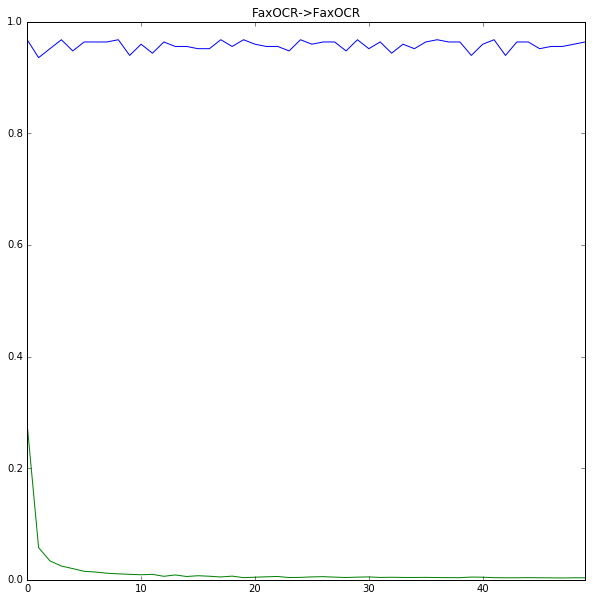
これは前回と同様な感じ。だいたいOK。
MNIST -> FaxOCR (28x28)
accuracy = pd.read_csv("./results/mnist_28_accuracy_row.txt", sep="\t")
loss = pd.read_csv("./results/mnist_28_loss_row.txt", sep="\t")
fig = plt.figure(figsize=[10,10])
accuracy["test_accuracy"].plot()
plt.ylim([0,1])
loss["train_loss"].plot()
plt.title("MNIST->FaxOCR")
plt.show()

残念ながらこれも前回と同じ。どうもミスとかではなく、普通にダメそう。
loss自体は下がっているので、MNISTとFaxOCRのデータが何かしら違うことが原因っぽい。
データをみる
個々のデータを目で見ていても、特に不自然なところはないように感じたので、色々絵を描いてみて考えることにした。
from learn import read_imgs
mnist_data, mnist_label = read_imgs("./data/mnist/train/28")
faxocr_data, faxocr_label = read_imgs("./data/faxocr/train/28")
print mnist_data.mean()
print faxocr_data.mean()
0.131017957897
0.079225616316
画素の平均値が違っているのが少し気になる。
t-SNE
まずは僕の大好きなt-SNEで絵を描く。
前回はMNISTを1000個とFaxOCRのテストデータを使って可視化したけど、今回はMNISTデータ7000個とFaxOCRの学習データ6709個を使った。
num_mnist = 7000
import random
indecies = random.sample(range(len(mnist_data)), num_mnist)
data = np.r_[mnist_data[indecies].reshape(num_mnist, -1), faxocr_data.reshape(len(faxocr_data),-1)]
from sklearn.manifold import TSNE
model = TSNE(n_components=2)
tsned = model.fit_transform(data)
label = np.r_[["b" for i in range(num_mnist)], ["r" for i in range(len(faxocr_data))]]
plt.figure(figsize=(30,30))
plt.scatter(tsned[:,0], tsned[:,1], c=label, linewidths=0)
plt.show()
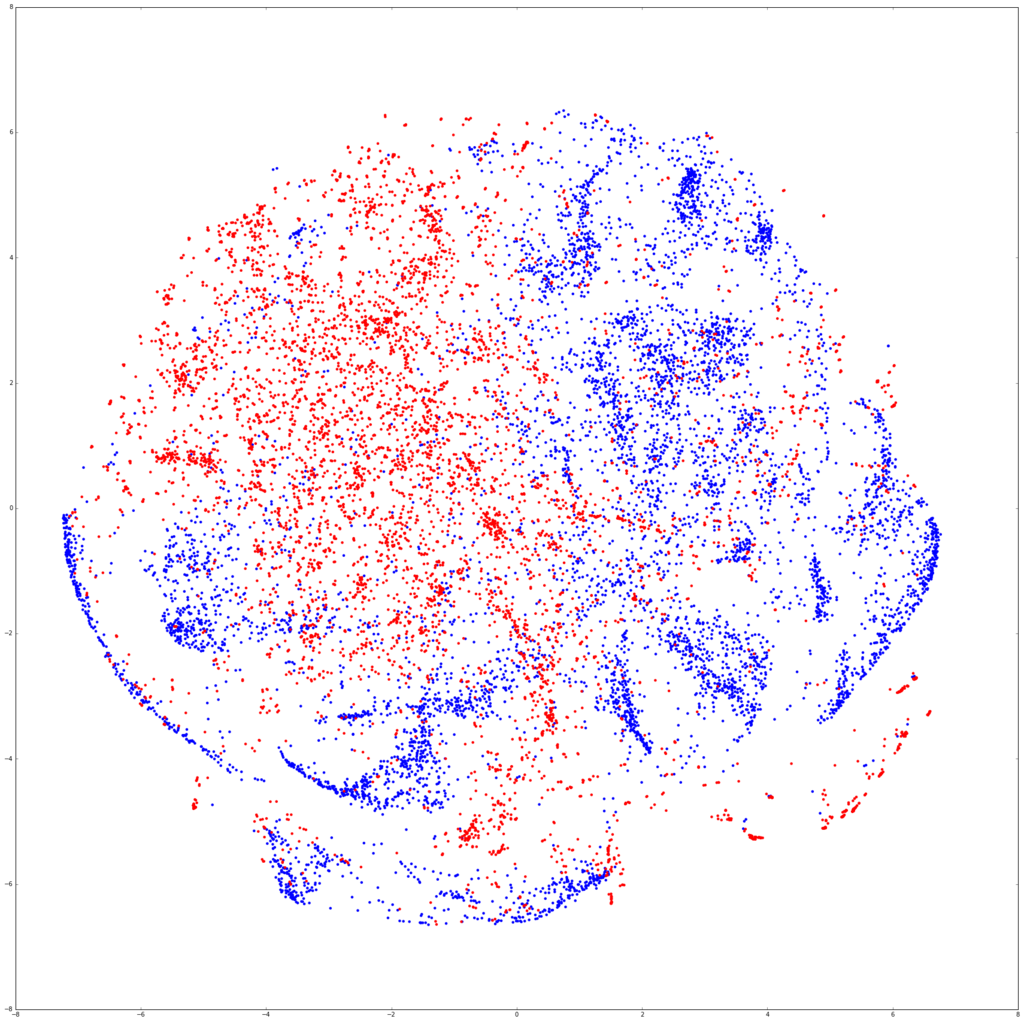
青がMNIST、赤がFaxOCR。分離してるなぁーって感じの図。わかりにくいので、数字ごとに図を描いてみる。
fig = plt.figure(figsize=(30,40))
for num in range(10):
fig.add_subplot(4,3,num+1)
label = np.r_[["b" if i==num else "w" for i in mnist_label[indecies]], ["r" if i==num else "w" for i in faxocr_label]]
plt.scatter(tsned[:,0], tsned[:,1], c=label, linewidths=0, alpha=0.6, marker=".")
plt.title(str(num))
plt.show()

まあだめでしょうねって感じの図になった。
ちょっと気になったので、FaxOCRデータとMNISTデータそれぞれでt-SNEして図を描いてみる。
model_faxocr = TSNE(n_components=2)
tsned_faxocr = model_faxocr.fit_transform(faxocr_data.reshape(len(faxocr_data),-1))
model_mnist = TSNE(n_components=2)
tsned_mnist = model_faxocr.fit_transform(mnist_data[indecies].reshape(num_mnist,-1))
plt.figure(figsize=(20,10))
plt.subplot(121)
plt.title("FaxOCR")
plt.scatter(tsned_faxocr[:,0], tsned_faxocr[:,1], c=faxocr_label, linewidths=0, marker=".")
plt.subplot(122)
plt.title("MNIST")
plt.scatter(tsned_mnist[:,0], tsned_mnist[:,1], c=mnist_label[indecies], linewidths=0, marker=".")
plt.show()

なんだこれは。MNISTの方はすごいきれいに分かれているのに。
ちなみに回転させたデータを入れたFaxOCRのデータを可視化すると以下。
new_imgs = []
new_labels = []
size = tuple(np.array([faxocr_data[0].shape[1], faxocr_data[0].shape[0]]))
from itertools import izip
import cv2 as cv
for img, label in izip(faxocr_data, faxocr_label):
for i in range(20):
rad = (random.random() - 0.5) * 0.5
pos1 = (random.random() - 0.5) * 5
pos2 = (random.random() - 0.5) * 5
mat = np.float32([[np.cos(rad), -1 * np.sin(rad), pos1],
[np.sin(rad), np.cos(rad), pos2]])
dst = cv.warpAffine(img, mat, size, flags=cv.INTER_LINEAR)
new_imgs.append(dst)
new_labels.append(label)
many_data = np.r_[faxocr_data, new_imgs]
many_label = np.r_[faxocr_label, new_labels]
fax_indecies = random.sample(range(len(many_data)), num_mnist)
model_many = TSNE(n_components=2)
tsned_many = model_many.fit_transform(many_data.reshape(len(many_data),-1)[fax_indecies])
plt.figure(figsize=(10,10))
plt.scatter(tsned_many[:,0], tsned_many[:,1], c=many_label[fax_indecies], linewidths=0, marker=".")
plt.show()

このデータ分離できるというのはCNNがすごいのかt-SNEがいまいちなのかなんなんだ。
というかMNISTのデータはなんであんなに綺麗に描けるんだ。
どの点がどの画像なのかを見る。
数字ごとに分けて書いた図を見ているとどうもMNISTとFaxOCRで被っている点もある。その点がどの点なのかを見ることで、何かわかるんじゃないかと思って、以下のように可視化した。
MNISTとFaxOCRの点が重なっているところで緑とかになっているのは、直すのがめんどうなだけなので気にしないでほしい。(これ系の図のもっと楽な書き方を知っている人がいたら教えて欲しいです…)
img_size = 28 * 100
label = np.r_[mnist_label[indecies].reshape(num_mnist, -1), faxocr_label.reshape(len(faxocr_data),-1)]
positions = (tsned - tsned.min()) *img_size/(tsned.max() - tsned.min())
plt.figure(figsize=(50*2,50*5))
for num in range(10):
plt.subplot(5,2,num+1)
img = np.ones((img_size, img_size, 3))
for i, pos in enumerate(positions):
if label[i] != num:
continue
temp = data[i].reshape(28,28)
if i < num_mnist:
temp = np.c_[ np.zeros([784]), data[i], data[i]]
else:
temp = np.c_[data[i], data[i], np.zeros([784])]
temp = temp.reshape(28,28,3)
if pos[0]-14<0 or pos[0]+14>img_size or pos[1]-14<0 or pos[1]+14>img_size:
continue
img[pos[0]-14:pos[0]+14, pos[1]-14:pos[1]+14, :] -= temp
plt.imshow(img)
plt.title(num)
plt.show()
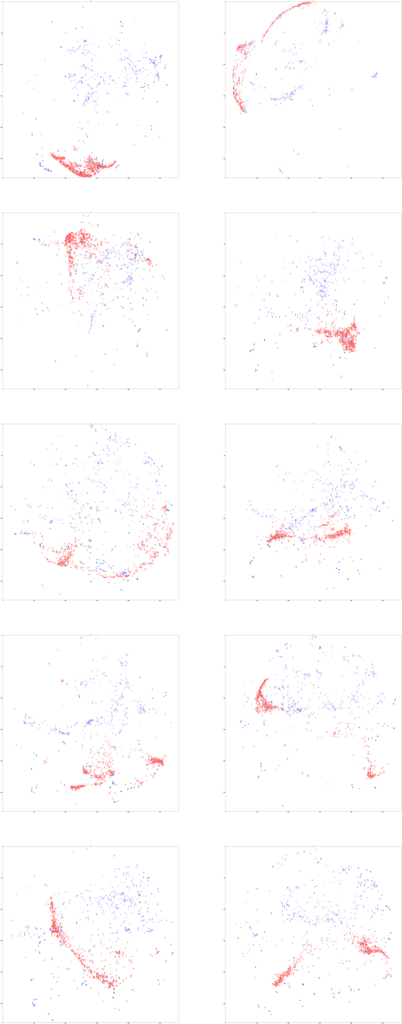
図をぼんやり眺めていると、「これ字のサイズが違うだけじゃね」って思い始めた。
(図が縮小されてわからないと思うので、こちらに元サイズの画像をおいた。ちなみに5492x13993ある。)
画像中の文字の大きさを統一する
FaxOCRのデータは元データをそのまま入力しているので、大きさが統一されていない。MNISTのデータも色々な大きさの数字が混ざっているんだろうと思い込んでいたんだけど、どうもそうでもないみたい。
ちゃんと公式サイトみると、
"The digits have been size-normalized and centered in a fixed-size image."
って書いてあった。
というわけで同様の処理をFaxOCRのデータにも行う。
トリミングして数字を画像の中心にもってきてってやるの、ちゃんとプログラム書くとそこそこめんどうだなぁと思っていたけど、
ImageMagickで探してみたら意外とあったので、以下のようにコマンドを叩いてぱぱっとやる。
こちらとこちらを参考にした。
for i in *
do
convert -fuzz %60 -trim $i ../trim/$i
done
cd ../trim
for i in *
do
convert $i -background white -gravity center -thumbnail 28x28 -extent 28x28 ../trim_28/$i
done
余白の設定がめんどうだったので、FaxOCRだけでなくMNISTのデータにも適応した。
できた画像は以下のような感じ
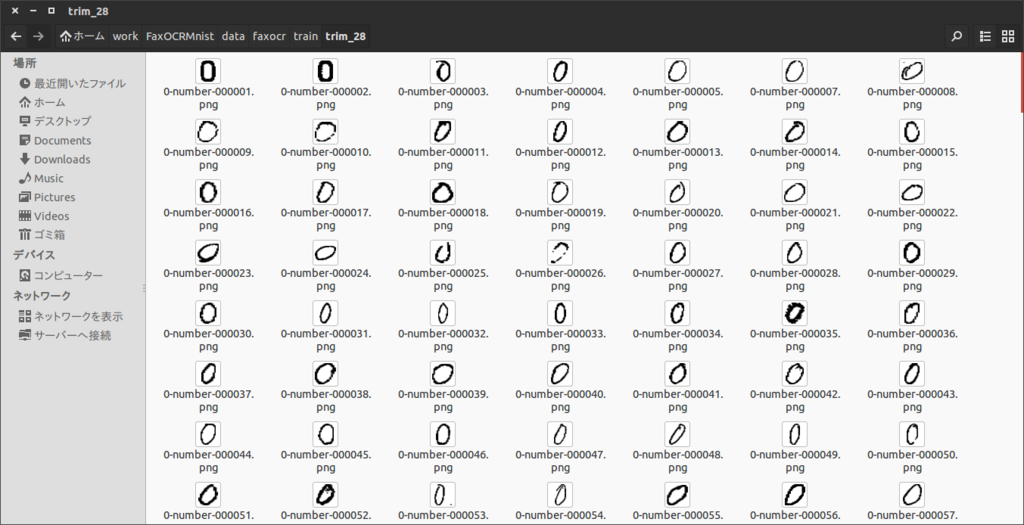
再びt-SNE
サイズを調整した画像を再びt-SNEに突っ込んで可視化する。
from learn import read_imgs
mnist_data, mnist_label = read_imgs("./data/mnist/train/trim_28")
faxocr_data, faxocr_label = read_imgs("./data/faxocr/train/trim_28")
print mnist_data.mean()
print faxocr_data.mean()
num_mnist = 7000
import random
indecies = random.sample(range(len(mnist_data)), num_mnist)
data = np.r_[mnist_data[indecies].reshape(num_mnist, -1), faxocr_data.reshape(len(faxocr_data),-1)]
0.298007055179
0.206816194953
from sklearn.manifold import TSNE
model = TSNE(n_components=2)
tsned = model.fit_transform(data)
label = np.r_[["b" for i in range(num_mnist)], ["r" for i in faxocr_data]]
plt.figure(figsize=(30,30))
plt.scatter(tsned[:,0], tsned[:,1], c=label, linewidths=0)
plt.show()

img_size = 28 * 100
label = np.r_[mnist_label[indecies].reshape(num_mnist, -1), faxocr_label.reshape(len(faxocr_data),-1)]
positions = (tsned - tsned.min()) *img_size/(tsned.max() - tsned.min())
plt.figure(figsize=(50*2,50*5))
for num in range(10):
plt.subplot(5,2,num+1)
img = np.ones((img_size, img_size, 3))
for i, pos in enumerate(positions):
if label[i] != num:
continue
temp = data[i].reshape(28,28)
if i < num_mnist:
temp = np.c_[ np.zeros([784]), data[i], data[i]]
else:
temp = np.c_[data[i], data[i], np.zeros([784])]
temp = temp.reshape(28,28,3)
if pos[0]-14<0 or pos[0]+14>img_size or pos[1]-14<0 or pos[1]+14>img_size:
continue
img[pos[0]-14:pos[0]+14, pos[1]-14:pos[1]+14, :] -= temp
plt.imshow(img)
plt.title(num)
plt.show()
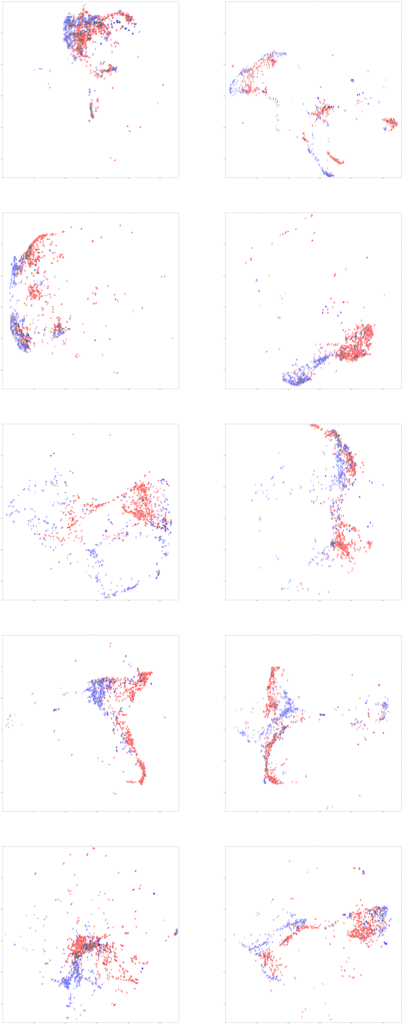
元サイズ画像
model_faxocr = TSNE(n_components=2)
tsned_faxocr = model_faxocr.fit_transform(faxocr_data.reshape(len(faxocr_data),-1))
plt.figure(figsize=(30,30))
plt.scatter(tsned_faxocr[:,0], tsned_faxocr[:,1], c=faxocr_label, linewidths=0)
plt.show()
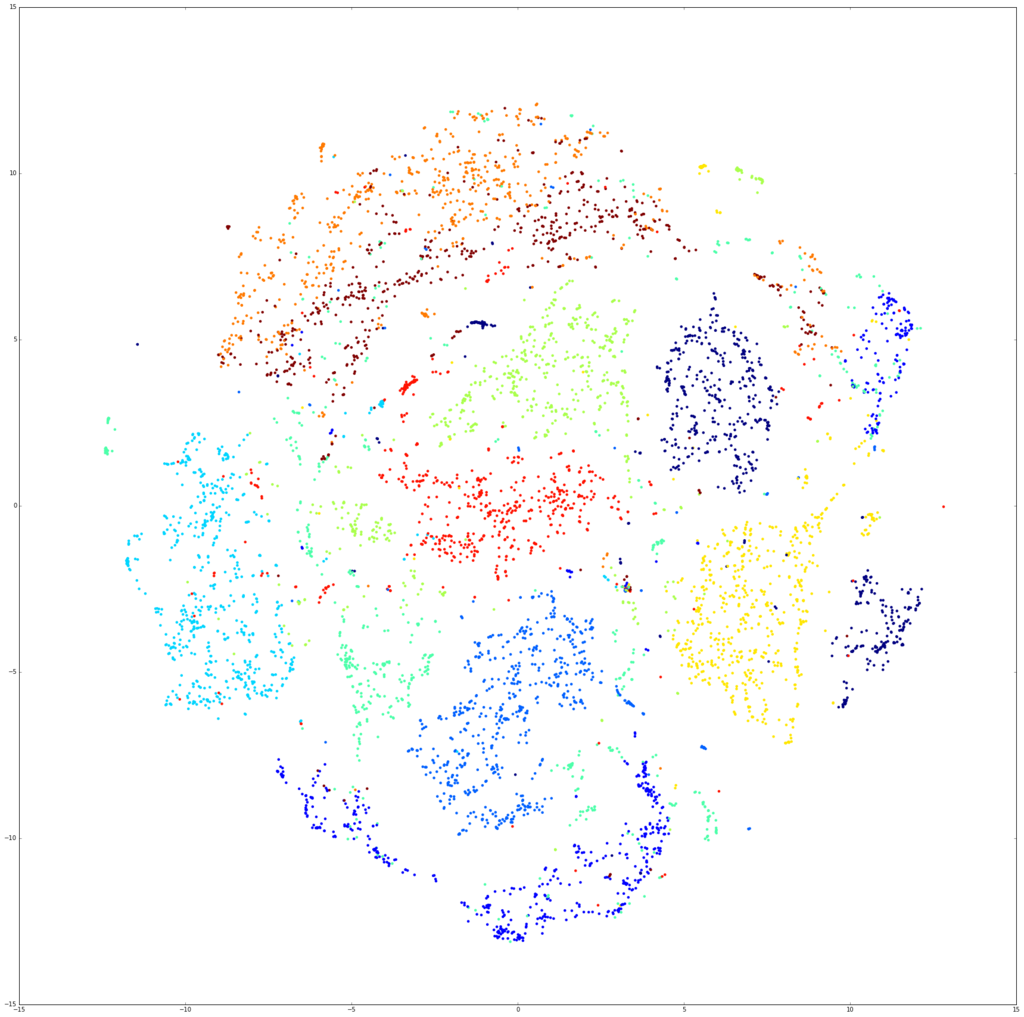
あ、これいけるわ。
再びCNN
いけそうなのでCNNに突っ込んだ。結果は以下。
fig = plt.figure(figsize=[20,10])
plt.subplot(121)
accuracy = pd.read_csv("./results/mnist_trim_28_accuracy_row.txt", sep="\t")
loss = pd.read_csv("./results/mnist_trim_28_loss_row.txt", sep="\t")
print accuracy
accuracy["test_accuracy"].plot()
plt.ylim([0,1])
loss["train_loss"].plot()
plt.title("MNIST trim -> FaxOCR trim")
plt.subplot(122)
accuracy = pd.read_csv("./results/mnist_28_accuracy_row.txt", sep="\t")
loss = pd.read_csv("./results/mnist_28_loss_row.txt", sep="\t")
accuracy["test_accuracy"].plot()
plt.ylim([0,1])
loss["train_loss"].plot()
plt.title("MNIST->FaxOCR")
plt.show()
epoch test_accuracy
0 1 0.787149
1 2 0.867470
2 3 0.895582
3 4 0.947791
4 5 0.931727
5 6 0.923695
6 7 0.931727
7 8 0.955823
8 9 0.935743
9 10 0.939759
10 11 0.927711
11 12 0.959839
12 13 0.955823
13 14 0.955823
14 15 0.931727
15 16 0.931727
16 17 0.923695
17 18 0.951807
18 19 0.935743
19 20 0.951807
20 21 0.951807
21 22 0.959839
22 23 0.951807
23 24 0.955823
24 25 0.939759
25 26 0.963855
26 27 0.951807
27 28 0.959839
28 29 0.963855
29 30 0.955823
30 31 0.963855
31 32 0.951807
32 33 0.967871
33 34 0.967871
34 35 0.967871
35 36 0.963855
36 37 0.979920
37 38 0.959839
38 39 0.967871
39 40 0.971888
40 41 0.951807
41 42 0.967871
42 43 0.959839
43 44 0.967871
44 45 0.971888
45 46 0.971888
46 47 0.947791
47 48 0.927711
48 49 0.959839
49 50 0.927711
MNISTだけで学習したCNNを使って、無事90%を超えるぐらいの精度は出すことができた。
右は最初にやった正規化していないデータ。
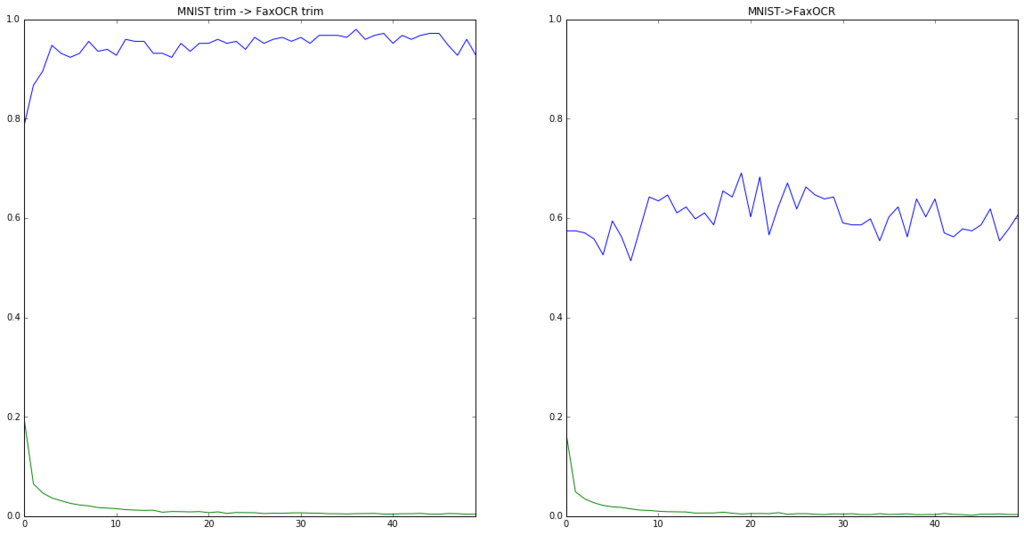
おわりに
normalize大事という意識は今までもあったつもりだったけど、正直ここまでとは思ってなかった。
今回は特にnormalizeされたデータであるMNISTのデータを使って、normalizeされてないFaxOCRのデータを認識しようとしていたのが良くなかった。実際にFaxOCRのデータでFaxOCRのデータを予測すると、それなりに上手くいっていた。CNNがきちんと学習してくれていたんだと思う。
一方でt-SNEを、正規化していないFaxOCRのデータに対して適用すると、かなりまずいことになっていた。今までなんとなくt-SNEに突っ込んで学習できそうかどうか見るというのをよくやっていたけど、もう少し気をつけたほうが良さそう。まずはt-SNEの論文をちゃんと読もうと思った。
おまけ
正規化したFaxOCRのデータを使って正規化したFaxOCRのデータを当てにいった。結果は以下。
28x28
fig = plt.figure(figsize=[10,10])
accuracy = pd.read_csv("./results/faxocr_trim_28_accuracy_row.txt", sep="\t")
loss = pd.read_csv("./results/faxocr_trim_28_loss_row.txt", sep="\t")
print accuracy
accuracy["test_accuracy"].plot()
plt.ylim([0,1])
loss["train_loss"].plot()
plt.title("FaxOCR trim -> FaxOCR trim 28x28")
plt.show()
epoch test_accuracy
0 1 0.975904
1 2 0.979920
2 3 0.983936
3 4 0.975904
4 5 0.983936
5 6 0.975904
6 7 0.991968
7 8 0.971888
8 9 0.971888
9 10 0.975904
10 11 0.979920
11 12 0.971888
12 13 0.979920
13 14 0.987952
14 15 0.983936
15 16 0.987952
16 17 0.979920
17 18 0.987952
18 19 0.979920
19 20 0.979920
20 21 0.983936
21 22 0.983936
22 23 0.971888
23 24 0.979920
24 25 0.983936
25 26 0.987952
26 27 0.983936
27 28 0.987952
28 29 0.975904
29 30 0.987952
30 31 0.983936
31 32 0.979920
32 33 0.979920
33 34 0.979920
34 35 0.967871
35 36 0.975904
36 37 0.971888
37 38 0.983936
38 39 0.983936
39 40 0.963855
40 41 0.979920
41 42 0.967872
42 43 0.967871
43 44 0.983936
44 45 0.983936
45 46 0.987952
46 47 0.983936
47 48 0.987952
48 49 0.975904
49 50 0.983936
何気に記録更新だった。たまたま感あるけど。

import cPickle as pickle
import chainer
from chainer import cuda
import chainer.functions as F
def forward(x_data, y_data):
x, t = chainer.Variable(x_data), chainer.Variable(y_data)
h = F.max_pooling_2d(F.relu(model.conv1(x)), 2)
h = F.max_pooling_2d(F.relu(model.conv2(h)), 2)
h = F.dropout(F.relu(model.l1(h)), train=False)
y = model.l2(h)
return y, t,F.accuracy(y,t)
with open("./results/faxocr_trim_28_model_cnn_row.pkl", 'rb') as i:
model = pickle.load(i)
from learn import read_imgs
test_data, test_label = read_imgs("./data/faxocr/test/trim_28")
test_data = test_data.reshape((len(test_data), 1, 28, 28))
test_data = test_data.astype(np.float32)
test_label = test_label.astype(np.int32)
y,t,acc = forward(test_data, test_label)
plt_num = 1
plt.figure(figsize=(10,10))
for i,(temp_y,temp_t,temp_test_data) in enumerate(izip(y.data,t.data, test_data)):
if np.argmax(temp_y)!=temp_t:
print "No.%d 正解:%d 出力:%d (%s)"%(i,temp_t, np.argmax(temp_y),temp_y)
plt.subplot(2,2,plt_num)
plt_num+=1
plt.imshow(temp_test_data.reshape(28,28), cmap=plt.cm.gray_r)
plt.show()
No.133 正解:9 出力:3 ([ -93.78523254 -76.56691742 -77.28510284 15.78890038 -87.52314758
-58.99074554 -176.7293396 -101.68743896 -67.08155823 14.66318226])
No.205 正解:9 出力:3 ([-44.00131989 -30.13937569 -40.71391678 17.24973297 -49.49590683
-39.89061356 -82.53543091 -53.00856781 3.72428441 3.67775631])
No.223 正解:9 出力:5 ([-24.54581642 -29.07642365 -31.50553131 -19.87841034 -23.92304039
22.30206299 -18.75444031 -1.30475843 -20.22147751 -21.81653404])
No.239 正解:5 出力:6 ([-12.27904129 -23.67368317 -23.48480606 -15.10187721 -11.83357048
2.34730673 4.19125843 -13.38466549 -3.61155844 -24.05160713])
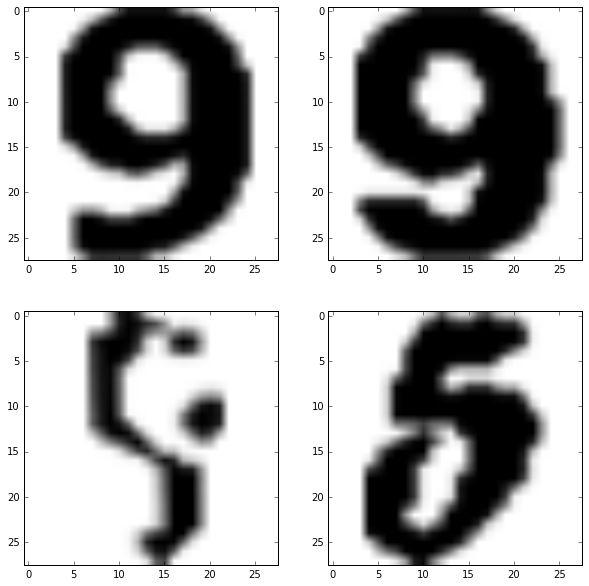
48x48
fig = plt.figure(figsize=[10,10])
accuracy = pd.read_csv("./results/faxocr_trim_48_accuracy_row.txt", sep="\t")
loss = pd.read_csv("./results/faxocr_trim_48_loss_row.txt", sep="\t")
print accuracy
accuracy["test_accuracy"].plot()
plt.ylim([0,1])
loss["train_loss"].plot()
plt.title("FaxOCR trim -> FaxOCR trim 48x48")
plt.show()
epoch test_accuracy
0 1 0.967871
1 2 0.967871
2 3 0.971888
3 4 0.971888
4 5 0.959839
5 6 0.975904
6 7 0.967871
7 8 0.967871
8 9 0.975904
9 10 0.971888
10 11 0.975904
11 12 0.979920
12 13 0.963855
13 14 0.975904
14 15 0.975904
15 16 0.971888
16 17 0.967871
17 18 0.963855
18 19 0.967871
19 20 0.975904
20 21 0.967871
21 22 0.963855
22 23 0.975904
23 24 0.971888
24 25 0.967871
25 26 0.967871
26 27 0.971888
27 28 0.971888
28 29 0.963855
29 30 0.963855
30 31 0.975904
31 32 0.967871
32 33 0.963855
33 34 0.979920
34 35 0.971888
35 36 0.967871
36 37 0.979920
37 38 0.979920
38 39 0.967871
39 40 0.975904
40 41 0.975904
41 42 0.975904
42 43 0.975904
43 44 0.979920
44 45 0.975904
45 46 0.979920
46 47 0.979920
47 48 0.975904
48 49 0.975904
49 50 0.975904
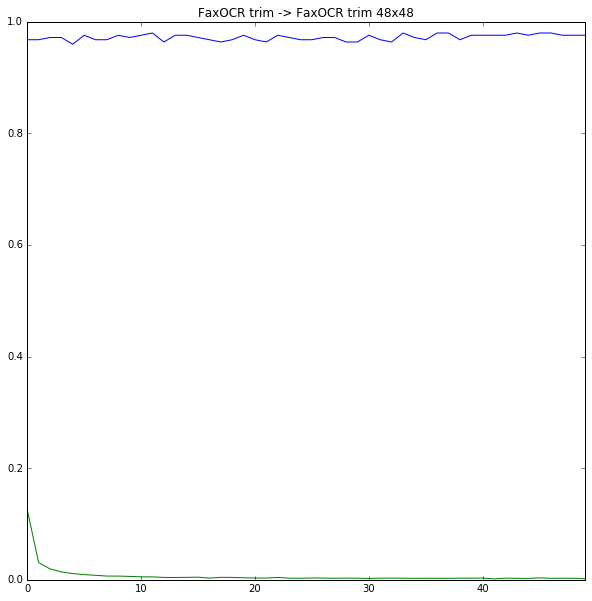
import cPickle as pickle
import chainer
from chainer import cuda
import chainer.functions as F
def forward(x_data, y_data):
x, t = chainer.Variable(x_data), chainer.Variable(y_data)
h = F.max_pooling_2d(F.relu(model.conv1(x)), 2)
h = F.max_pooling_2d(F.relu(model.conv2(h)), 2)
h = F.dropout(F.relu(model.l1(h)), train=False)
y = model.l2(h)
return y, t,F.accuracy(y,t)
with open("./results/faxocr_trim_48_model_cnn_row.pkl", 'rb') as i:
model = pickle.load(i)
from learn import read_imgs
test_data, test_label = read_imgs("./data/faxocr/test/trim_48")
test_data = test_data.reshape((len(test_data), 1, 48, 48))
test_data = test_data.astype(np.float32)
test_label = test_label.astype(np.int32)
y,t,acc = forward(test_data, test_label)
plt_num = 1
plt.figure(figsize=(10,10))
for i,(temp_y,temp_t,temp_test_data) in enumerate(izip(y.data,t.data, test_data)):
if np.argmax(temp_y)!=temp_t:
print "No.%d 正解:%d 出力:%d (%s)"%(i,temp_t, np.argmax(temp_y),temp_y)
plt.subplot(3,2,plt_num)
plt_num+=1
plt.imshow(temp_test_data.reshape(48,48), cmap=plt.cm.gray_r)
plt.show()
No.31 正解:7 出力:3 ([-37.6387825 -39.16486359 -42.47499466 16.941082 -35.50929642
-28.37680244 -50.37080765 -18.17589951 -43.64836502 -26.19575882])
No.185 正解:3 出力:7 ([-21.7053051 -26.57409286 -22.67599106 5.41281748 -29.81308937
-15.2016449 -49.91247177 11.7005167 -18.8066597 -14.08572674])
No.223 正解:9 出力:5 ([-26.99477196 -24.89096451 -43.02868652 -15.52783775 -25.02332115
22.98989105 -17.69327545 -12.22776604 -12.18619633 -25.91065407])
No.228 正解:8 出力:9 ([ -4.70918608 -52.99452972 -28.40055275 -29.08706474 6.42821693
-24.2097435 -52.58614731 -46.19430542 -14.41009426 12.67389202])
No.229 正解:2 出力:8 ([-22.11865997 -47.65965271 -1.94437969 -54.52325821 -24.92860031
-19.47817802 -17.64678574 -40.01361084 26.35980225 -27.82418633])
No.239 正解:5 出力:8 ([ -3.87564874 -33.8475914 -27.65610313 -16.90502548 -28.28848457
-23.67333221 -2.17319727 -35.55740356 22.8358345 -31.50007057])

間違えちゃいけないデータを間違えているような気もするけど、前処理が適当で画像ぼけてるのがあれかも。
あとMNISTのデータとFaxOCRのデータをくっつけると汎化性能とか上がっていい感じかも。
あとは、データのaugmentationをもうちょっとちゃんとやるとか、複数のCNNでアンサンブル的なやつとかと思うけど、そのへんはよくわかってない
参考























































